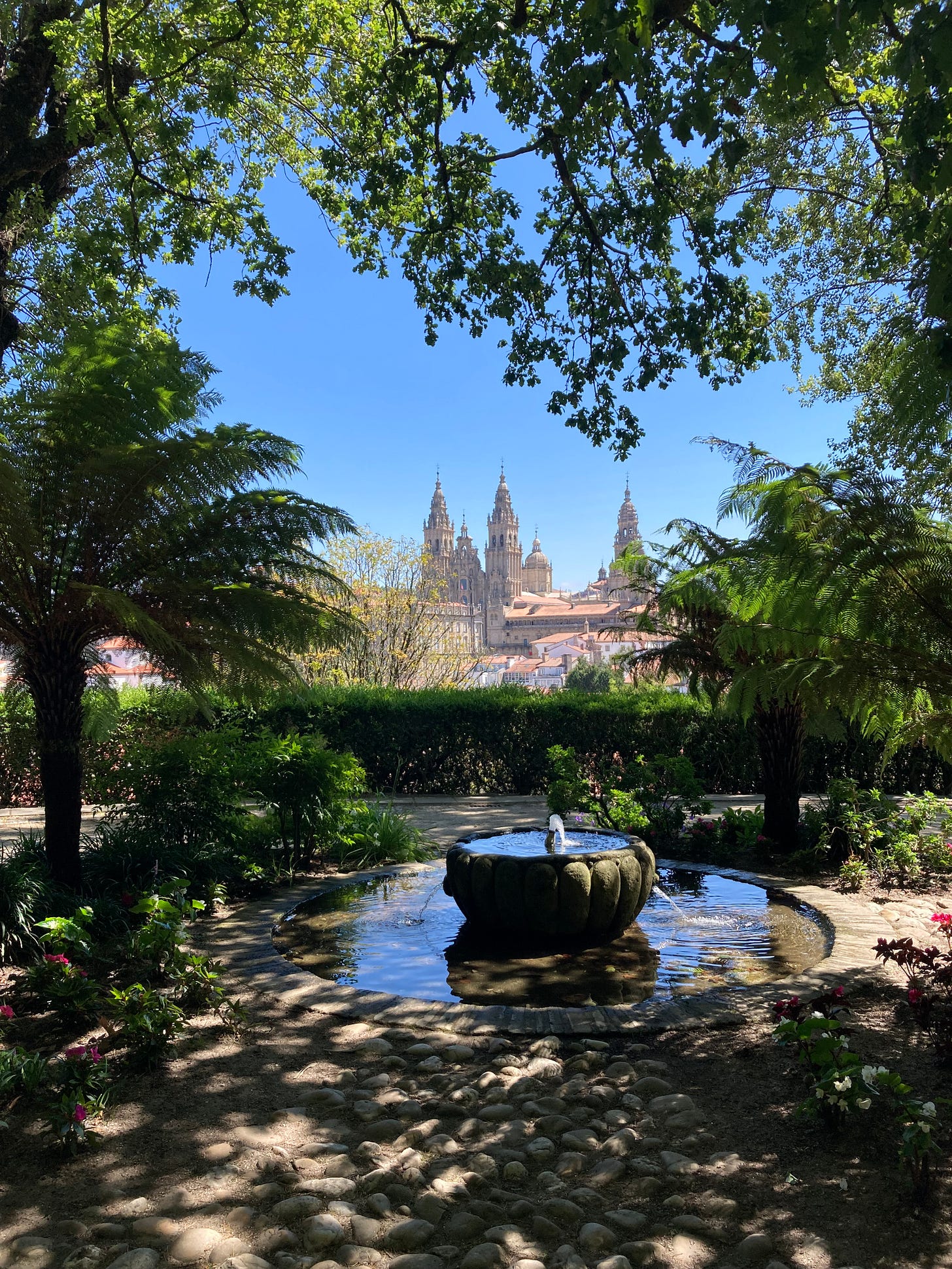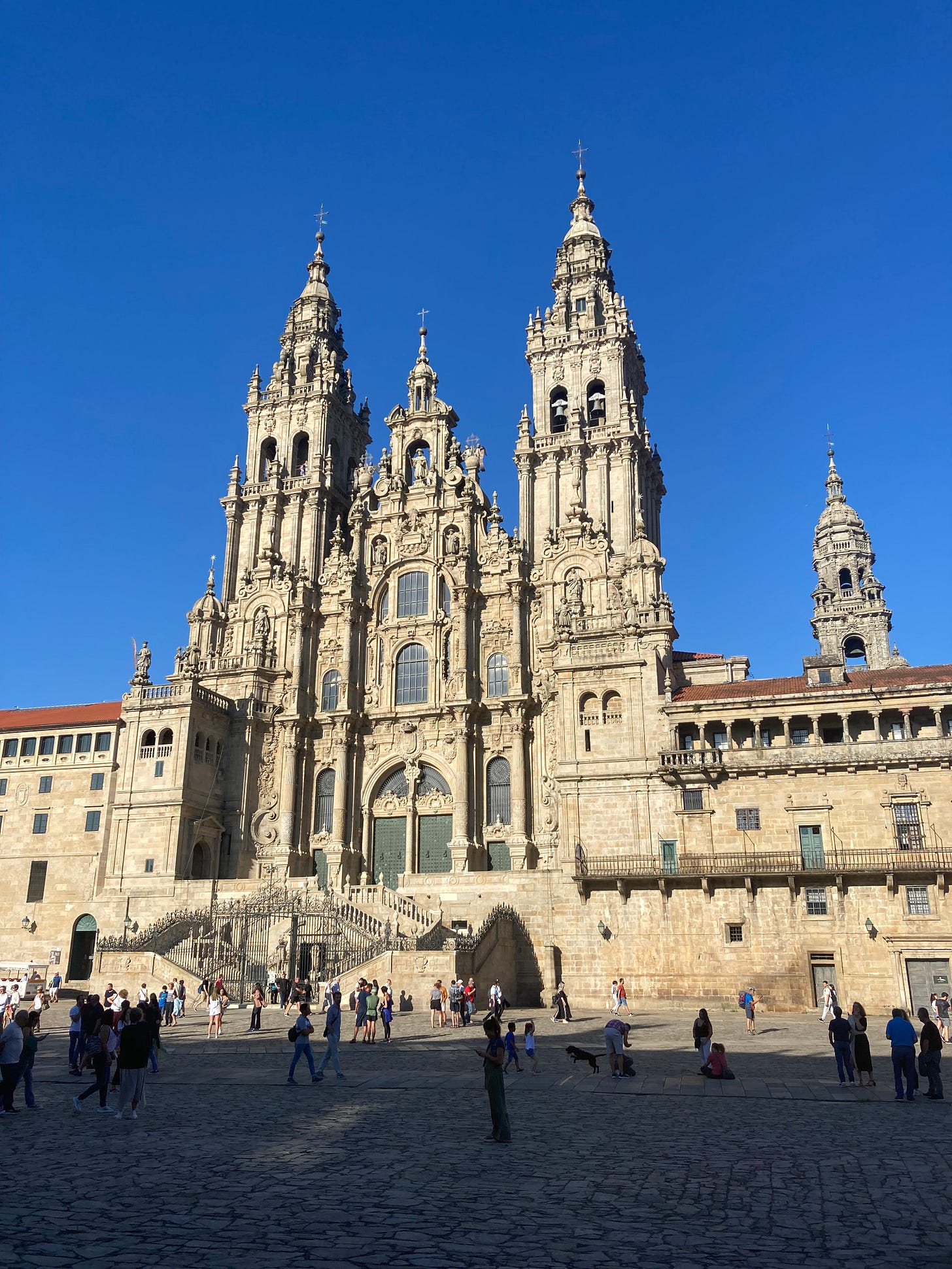When searching for a cohesive narrative of events, one can always turn to landscape, for it is landscape that stages phenomenon across time and space. In Santiago do Compostelo, the landscape, and by association the narrative, tells a clear and compelling story.
Topographically, Santiago do Compostelo sits in a shallow valley surrounded by rolling hills. If arriving by foot, cresting any of these hills slowly reveals the city, like a theatre curtain unfurling for the opening act of a play. Ecologically, there is a dramatic shift in biodiversity in Santiago do Compostelo, in comparison to other parts of Spain which are largely arid and dry. Santiago do Compostelo benefits from a conflunece of humid ocean air and rain from the torpid Atlantic Ocean to the west and from the Bay of Biscay to the north. As a result, the area is rich in flora, populated with mosses, ferns, cyprus trees, that don't grow elsewhere in Spain, and the earth is a fertile deep dark colour of brown. In fact, the second half of the city's name — Compostelo — is thought to be derived from the Latin compositella, which roughly translates to "the well-composed one", referencing cycles of decay, regeneration and growth. Then there are the caminos of St. James. Hundreds of them. Originating in all parts of Europe, from Poland and beyond. The map of the caminos reads like a capilliary diagram of the human body — you can't go 500 km in any direction without crossing one. They pass through every major city European city — Paris, Rome, London, Madrid — and all converge at Santiago do Compostelo. Take a walk through the surrounding countryside and you will inevitably come across a well-trodden camino, gently shaded by oak trees, seeming timeless, but still very much in use today by pilgrims, who every year number in the hundreds of thousands.
A narrative emerges from these topographical, ecological, climactic, and human-made characteristics. In Santiago do Compostelo, the word convergence is the operative term through which to understand the city. Convergence is defined as an act or process of merging. In Santiago do Compostelo, climates and caminos literally converge. This sets the stage for various conceptual merges. First, culturally. Indeed, pilgrims from essentially all European cultures walk the camino, and the shared spatial experience likely triggers pro-social behaviour. Second, Santiago do Compostelo's history, including its origin story about St. James' trip along the camino to the city, converges with the present when the pilgrims walk the same path. These instances of converge — both objective and figurative — led locals to adopt the scallop shell as the official symbol of Santiago do Compostelo and the Way of St. James. On branches of the camino in as far away places as Poland, you will find signposts with images of nothing more than a scallop and an arrow, pointing in the direction of the final destination thousands of kilometres away. The scallop shell's design embodies the principle of converge, in that the series of hard spokes that form that majority of scallop's shell all share the same point of origin and, when read in reverse, converge together at a single point, just like how climates, other caminos, European cultures, past and present, all converge on the city of Santiago do Compostelo.
Notably, the spokes of the scallop's don't end at their point of converge. A close examination reveals the spokes continue as one unit beyond their point of convergence, forming a fully filled triangle. Does this physical reality hold any conceptual connotations? Some historians claim that it was through the converge of the cultures of the pilgrims walking the camino that the concept of Europe itself emerged. It's a theory that makes sense — enforced proximity and shared goals facilitates pro-social behaviours. It's the same reason hundreds of thousands of people walk the camino today. Not to transact what is already known but to engage in a timeless act of self-discovery, where meaningful personal characteristics like integrity, dedication, community, vulnerability and humility emerge out of the process. The architecture of the city of Santiago do Compostelo plays an important role. The city's built form is characterized by stone pedestrian pathways compressed between tall and thin buildings, all squeezed up against each other. There are effectively no sightlines outwards towards the hills, towards the grand cathedral, and few unobstructed views of the sky. This is not a bad thing. Nearly all the buildings in the old city are beautiful medeival structures, but it is impossible to ignore their presence. By contrast, the city's main square, located right in front of the main Cathedral, is massive and completely open. It is surrounded by smaller, governmental buildings and — critically — two open spaces that let the light from the sunrise and light from the sunset in to shine on the Cathedral, giving it a golden glow. When a pilgrim arrive at either of these times, the experience is nothing less than transcendental.
Many pilgrims walk the Way of St. James in search of a narrative for their own lives, and the route's popularity is in part a due to its ability to provide a meaningful response. I argue that the forces of divine intervention are not at play, but rather the converging forces of landscape and architecture that, when coupled, produce emergent transcendental and pro-social experiences amongst the pilgrims with timeless and continent-wide implications.






